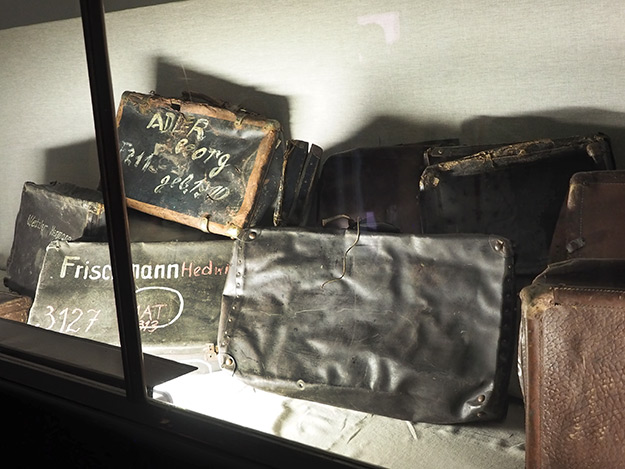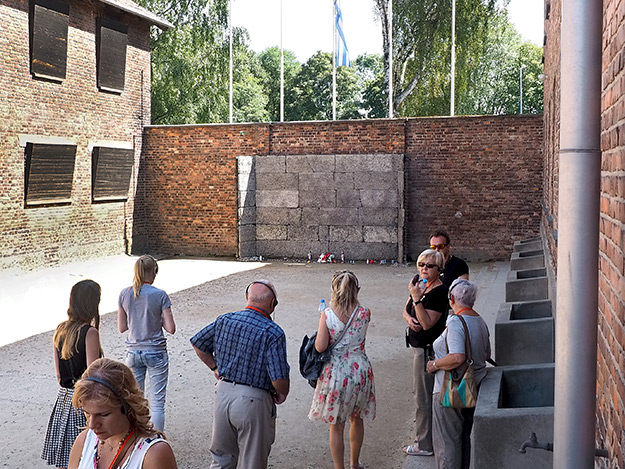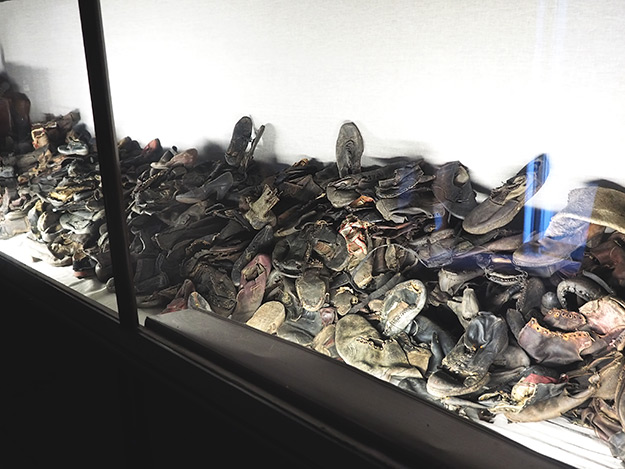During World War Two, the mass murder of millions of Jews, gypsies, Poles, homosexuals, mentally disabled, physically handicapped, and communists was the result of simple, vile ideas that were espoused by one hate-filled man. Hitler did not grow up hating Jews. As a young man he was a German Nationalist, however at that time he did not equate extreme nationalism with antisemitism. It was only after World War One that his anti-Jewish and anti-other sentiments began to emerge.

In the second chapter of his book, Mein Kampf (My Struggle), Hitler wrote:
“Today it is difficult, if not impossible, for me to say when the word ‘Jew ‘ first gave me ground for special thoughts. At home I do not remember having heard the word during my father’s lifetime. I believe that the old gentleman would have regarded any special emphasis on this term as cultural backwardness. In the course of his life he had arrived at more or less cosmopolitan views which, despite his pronounced national sentiments, not only remained intact, but also affected me to some extent…
…Not until my fourteenth or fifteenth year did I begin to come across the word ‘Jew,’ with any frequency, partly in connection with political discussions. This filled me with a mild distaste, and I could not rid myself of an unpleasant feeling that always came over me whenever religious quarrels occurred in my presence.
At that time I did not think anything else of the question.
There were few Jews in Linz. In the course of the centuries their outward appearance had become Europeanized and had taken on a human look; in fact, I even took them for Germans. The absurdity of this idea did not dawn on me because I saw no distinguishing feature but the strange religion. The fact that they had, as I believed, been persecuted on this account sometimes almost turned my distaste at unfavorable remarks about them into horror.
Thus far I did not so much as suspect the existence of an organized opposition to the Jews.
Then I came to Vienna.”

Hitler moved to Vienna in 1908 at the age of 17, hoping to attend the Vienna Academy of Fine Arts. Not only did the Academy turn down his application twice, he was rejected by the Austro-Hungarian Army as being unfit for military service. He lived several years in poor circumstances, selling his artwork to survive and absorbing the vitriolic antisemitism that was rampant at that time in Vienna. Finally, at the outbreak of WWI, Hitler returned to Munich and volunteered for service in the German Army.
As a soldier in WWI, Hitler bought into the myth that Germany had lost the war because they were betrayed by civilians, especially republicans who overthrew the monarchy in the German Revolution of 1918–19. This Dolchstoßlegende, or “stab-in-the-back” myth, was widely propagated by the German military in order to save face. To him, the “November Criminals” who signed the armistice leading to the Versailles Treaty were a collection of Social Democrats, Marxists, and Jews. Over time, Jews, as had been the wont throughout Europe since the Middle Ages, became scapegoats and were seen as the main reason Germany had lost the war.
After his rise to power in 1933-34, Hitler began systematically eliminating Jews by exporting them to concentration camps. I visited one of those camps during my recent trip to Krakow, Poland. My blood ran cold as I read the words that stretched over the entrance of the camp, “Arbeit Macht Frei” (Work Makes You Free). Out of 1.3 million deportees, only 400,000 were imprisoned at the camp. The remainder were immediately sent to the gas chambers. The remaining 400,000 were tasked with hard labor and fed rations of soup with a few lumps of potatoes once a day. Within months, most prisoners were dead of starvation, sickness, or exhaustion. The irony of “Arbeit Macht Frei” was not lost on me.

I felt like I’d entered the Twilight Zone as I followed a thoughtful and compassionate tour guide throughout the grounds. Except for the occasional watchtower and barbed wire barriers, the rows of red brick buildings looked so normal. They could have been any middle-class housing project. But signage told a different story. In one block, several hundred prisoners, mainly Jewish, were used as human guinea pigs for sterilization experiments conducted by a German gynecologist. Most of those who did not die from the painful treatments were murdered so that autopsies could be conducted on them.
From 1941 to 1943, Hitler’s feared Schutzstaffel paramilitary force (commonly known as the SS), shot several thousand prisoners in a walled courtyard between Blocks 10 and 11. The SS also administered brutal punishments in this courtyard, including floggings and a torture known as “the post,” where prisoners were hung from a post by their wrists with their arms twisted behind their backs.

One building was entirely devoted to displays of possessions brought to the camp by prisoners who believed they were there to start a new life. Piles of luggage, each bag bearing the name of the owner in white chalk, sat behind one plate glass window. Behind another, a pile of dishes and ceramics; yet another held a mound of shoes confiscated by the Nazis. Out of respect, no photos were allowed in a fourth display room. As my eyes adjusted to the darkened light, I was horrified. A mountain of human hair, shaved from the scalps of the dead, had been abandoned in the final days of World War II. The Nazis found it an ideal material for stuffing pillows and weaving rugs.
Perhaps most unsettling was the ruins of the crematorium, which was blown up by the Nazis just before they fled the approaching Russian liberating army. The facility seemed so small. I simply could not wrap my brain around the idea that at least 900,000 deportees had been gassed to death within its unassuming walls.

In the three months that have passed since my visit to Auschwitz, I have listened to the vitriolic rhetoric of the man who will soon become the President of the United States of America. I shudder at the prospect. I cannot help but draw correlations. The man who has denigrated Moslems, Mexicans, homosexuals, and women, among others, will soon take the reins of our country. Who has said that people who do not snitch on their neighbors should be prosecuted. The man who has said he does not mind being compared to Hitler will be the most powerful person in the world. This is how it began with Hitler. Slowly, one step at a time, with an unbelieving German public that became unable to do anything once his power was unassailable. I look at Mr. Trump and I am afraid. I am very, very afraid.
If you found this article about Auschwitz Concentration Camp worthwhile, you may also wish to read my story about visiting Dachau Concentration Camp near Munich, Germany. For more information about visiting the site, click here.

This article on visiting Auschwitz is deeply moving and thoughtfully written. It provides a poignant reflection on the emotional impact of visiting such a significant historical site, while also offering practical advice for those planning their own visit. The author’s sensitive approach to discussing the harrowing history of Auschwitz, combined with personal observations, creates a powerful and respectful guide. This is an essential read for anyone considering a visit to this important memorial. Excellent work in conveying both the gravity and significance of the experience.
Hi, I come from Poland and I’ve been to Auschwitz first time on a school trip when I was 16. It was a difficult experience and it took me 10 years to dare and go back there and look at all this again with adult eyes. It is horrific – but I think everybody should visit such place at least once, to learn… remember the lesson so that we, as humans can prevent such tragedy from happening again. Luckily, in 2019 Trump didn’t get anywhere close to being like Hitler – and let’s hope nobody ever will.
All the best
I completely agree Dorota. Everyone needs to visit one of these sites. The old adage is true – we are bound to repeat the history we forget.
I know how you feel. Not just for the USA but for the whole world. I left the killing fields in Cambodia, at around the time the elections happened. I left that place wondering how in the world such horrible things could happen, and so recently. I read about Pol Pot and my brain instantly thought of Trump. I started to get very scared.
I wrote a blog post on my thoughts a few days after the election results http://www.acreativenomad.com/blog/blog/boycotting-trump-media/
I am not normally a political person but the idea that in we think we are so forward in the world now and we have come so far…. I guess knowing that history repeats itself scares me.
Hi Rebecca: Just read your post and I can certainly relate to how you feel. I’m feeling quite hopeless and lost at the moment, and absolutely ashamed of what is happening in my country.
Dear Barbara,
I read your Auschwitz article with interest, as I do most of your articles since discovering your blog just a few months ago. Auschwitz must have been a challenging place to visit and I think your writing was evocative and poignant. I applaud your gumption to travel and write. Many of us who feel kind of stuck at home live vicariously through your writings as we plan for future travel.
It was remarkable to me that the final paragraph of your Auschwitz article should draw a correlation between the US President-Elect Donald Trump and Adolf Hitler. I don\’t understand on what basis you made that leap. Have you read Trump\’s Position on Immigration at DonaldJTrump.com? Or his Positions on other matters? Nothing in his plans sound remotely close to the language written by Adolf Hitler. Under President Trump\’s policies, no one in the United States is going to be treated as they were at Auschwitz or other WWII German concentration camps. Your fears are extreme, I think.
That being said, I\’ll quote Beatrice Evelyn Hall (commonly attributed to Voltaire), \”I disapprove of what you say, but I will defend to the death your right to say it.\” Your published words will not be burned in the United States as they very well might have been under the Third Reich.
And I\’ll keep reading your inspirational travel writings and continue to enjoy the beautiful photography, mentally editing any political free speech you may choose to interject. It\’s your right as an American to say and write what you wish and you will continue to enjoy that right under President Trump.
Best wishes,
Susan